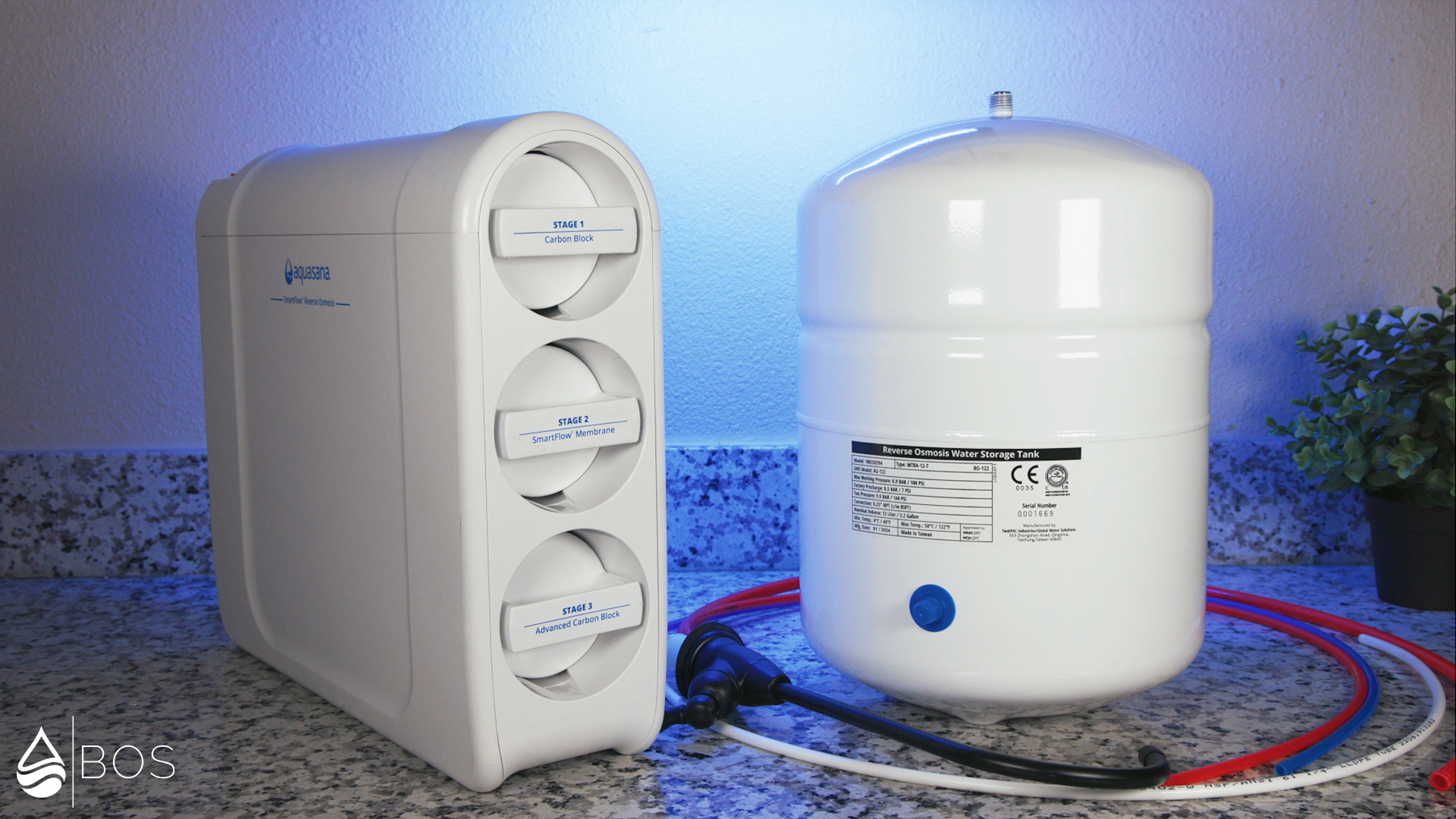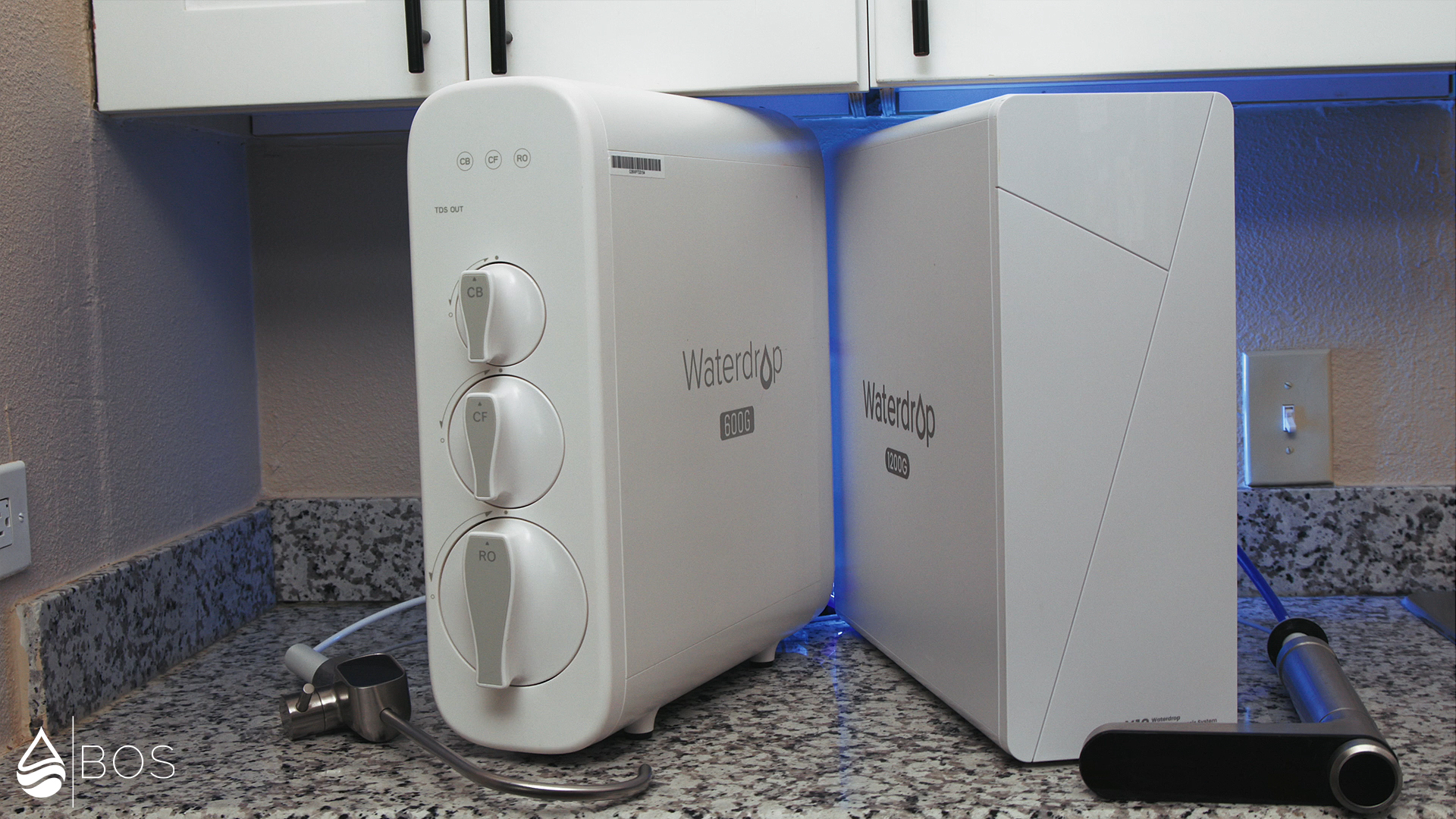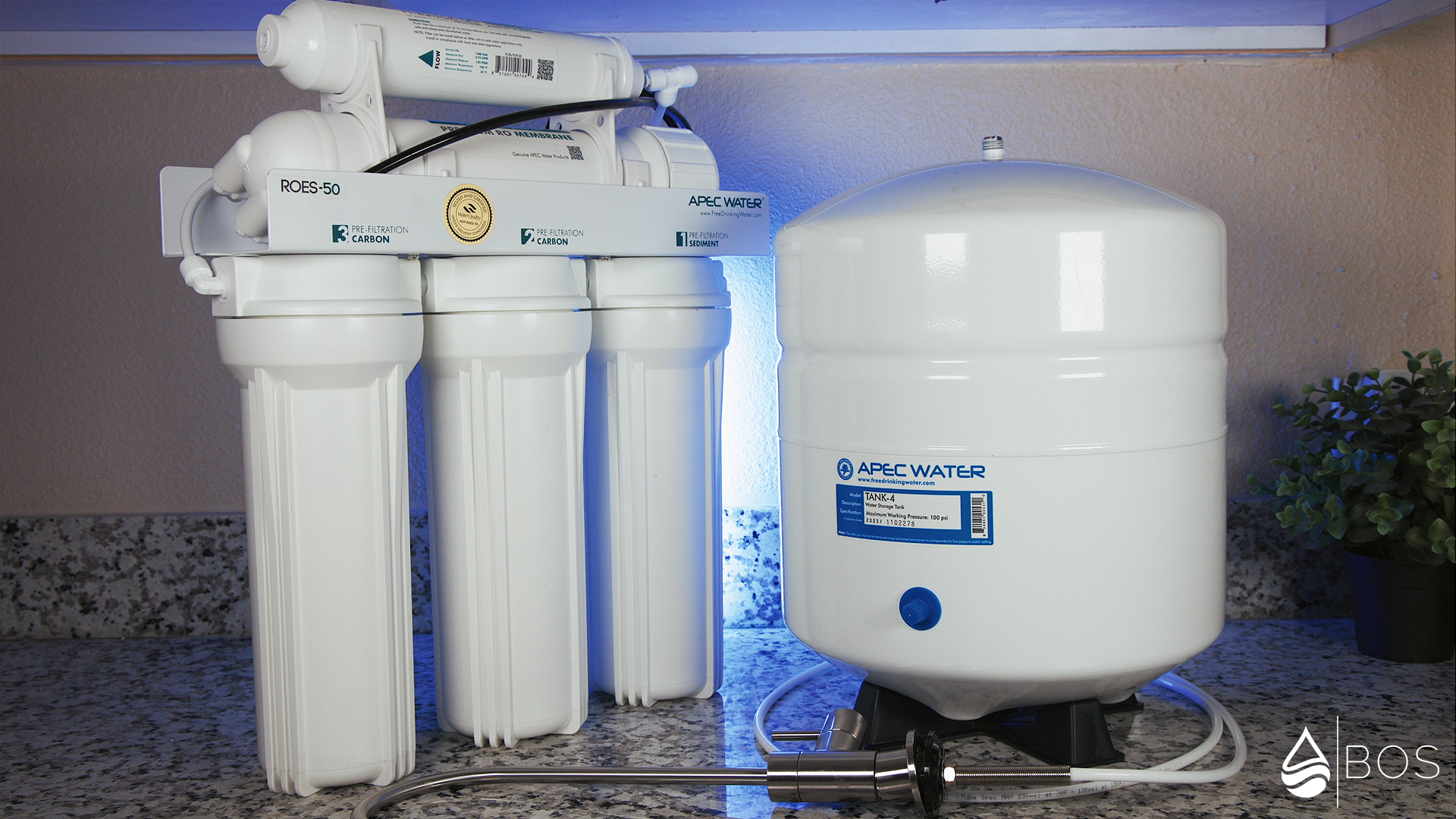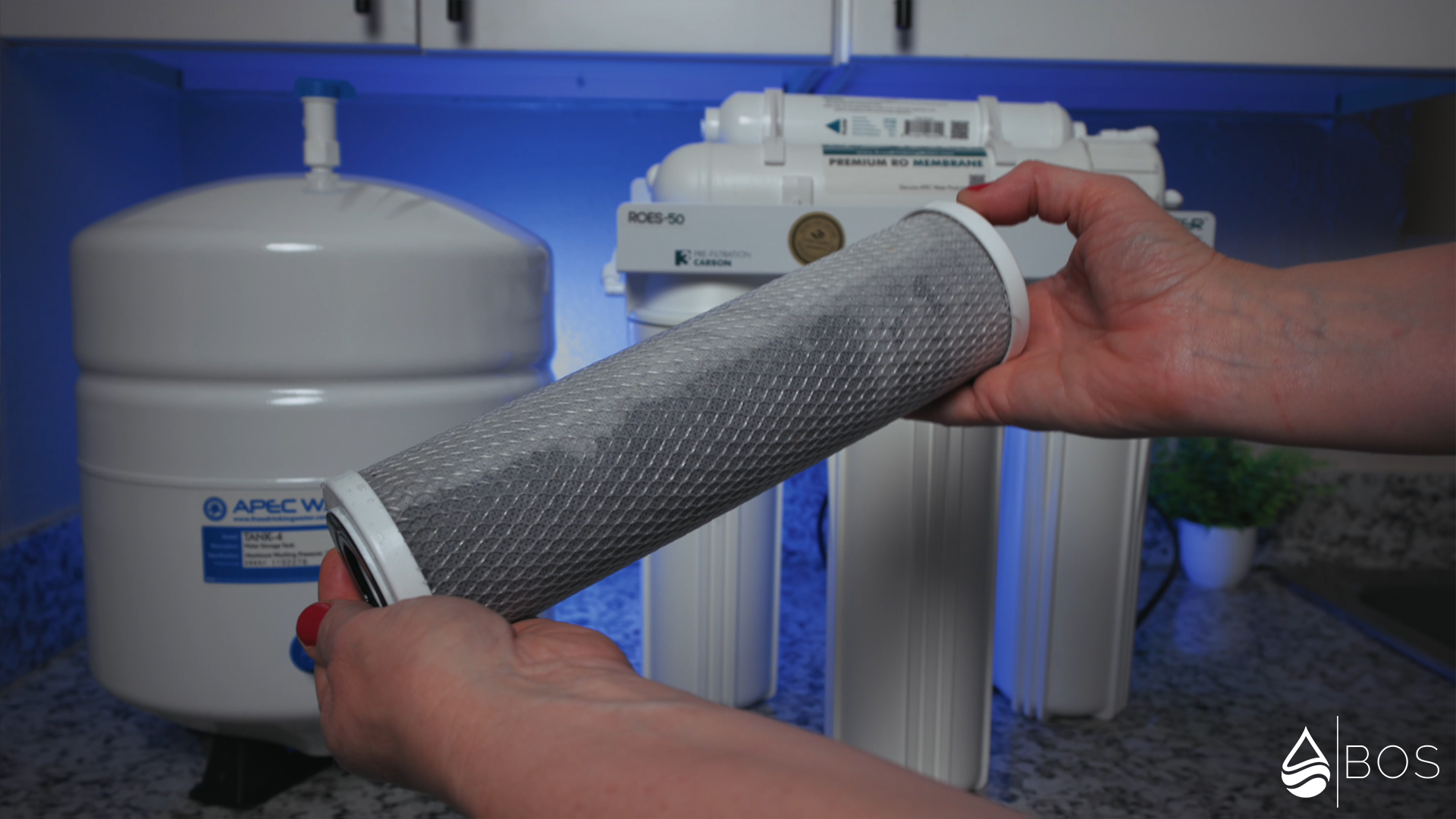Please note: Prices last checked on August 5, 2024 and March 4, 2025 (countertop ROs) and May 5, 2025 (under sink ROs). Costs were adjusted if a company has provided us with a discount code (discounts requiring some kind of subscription didn’t count). We may also have adjusted annual cost if a manufacturer’s stated filter lifespan appeared unrealistic.
Key Takeaways
Based on our lab testing and comparison of 21 different systems, a good reverse osmosis system usually costs anywhere between $200 and $550 upfront, and about $100-200 in annual filter replacements.
A brief summary of our data:
- Upfront costs in our under sink RO comparison are about $200 to $1,000+.
- Upfront costs in our countertop RO comparison are about $190 to $550.
- There are good filters in each sub-category: Tank-based and tankless under sink RO systems and countertop RO systems.
- We estimate the average upfront price of tank-based under sink ROs at $275.00 and regular countertop ROs at $310.00 (without hot or cold water options), whereas tankless under sink ROs cost more at $450.00 on average.
- Average annual filter replacement cost for countertop RO systems in our comparison is about $150.00, whereas for under sink models it’s ~$200.00.
- Our top pick tank-based under sink RO system costs $549.00 upfront and ~$200 annually.
- Our top pick tankless under sink RO system costs ~$460 upfront and ~$145 annually.
- Our top pick countertop RO system costs $349 upfront and ~$110 annually.
How much does a good reverse osmosis system cost in 2025, and how much do you need to invest if you want a top-performing RO water filter? Is there actually a difference between budget and premium-priced RO systems? What about under sink vs countertop ROs? To help you find the answer to those questions, we tested 21 popular under sink and countertop reverse osmosis systems first-hand!
Contents
Reverse Osmosis System Cost Overview

Below are the 25 under sink and countertop reverse osmosis systems that we examined in our comparison, including their upfront and long-term costs, as well as their key performance metrics.
| Reverse Osmosis System | AquaTru Classic | Cloud RO | Waterdrop G3P600 | AquaTru Carafe | Waterdrop X12 | Aquasana SmartFlow | US Water Systems All American 5-Stage RO | Home Master TMHP-L HydroPerfection Loaded | APEC ROES-50 Essence | Waterdrop A1 (Updated Version) |
NU Aqua 4-Stage Countertop RO System | Waterdrop C1H (Updated Version) |
Bluevua RO100ROPOT | APEC ROCT-PLUS | SimPure T1-400 ALK | Brondell H2O+ Circle | GE GXRQ18NBN | Frizzlife PD600-TAM3 | Frizzlife WB99-C | Crystal Quest Countertop Thunder | SimPure Y7P-BW |
|---|---|---|---|---|---|---|---|---|---|---|---|---|---|---|---|---|---|---|---|---|---|
 |
 |
 |
 |
 |
|||||||||||||||||
| Price (Mar 4 & May 5, 2025) | $349 | $549 | $458.15 | $259 | $1,035 | $239.99 | $579.45 | $530.04 | $199.95 | $550 | $427.45 | $250 | $434 | $349.95 | $227.49 | $449.99 | $229.99 | $349.99 | $259.99 | $192.12 | $295.99 |
| Our Yearly Cost Estimate (Aug 5, 2024 & May 5, 2025) | ~$110 | ~$200 | ~$145 | ~$150 | ~$175 | ~$360 | ~$185 | ~$217.50 | ~$100 | ~$130 | ~$100 | ~$120 | ~$180 | ~$140 | ~$252.50 | ~$205 | ~$320 | ~$165 | ~$172.50 | ~$200 | ~$120 |
| Final Rating | 4.83/5.00 | 4.66/5.00 | 4.65/5.00 | 4.66/5.00 | 4.49/5.00 | 4.11/5.00 | 4.52/5.00 | 4.45/5.00 | 4.53/5.00 | 4.42/5.00 | 4.38/5.00 | 4.39/5.00 | 4.42/5.00 | 4.21/5.00 | 4.40/5.00 | 4.18/5.00 | 4.26/5.00 | 4.24/5.00 | 4.16/5.00 | 2.97/5.00 | 3.68/5.00 |
| Filtration Score (Lab Results, NSF Certifications + Other Test Data, Taste & Odor Test) | 5.00/5.00 | 4.50/5.00 | 4.50/5.00 | 4.74/5.00 | 4.50/5.00 | 5.00/5.00 | 4.50/5.00 | 4.50/5.00 | 4.42/5.00 | 4.50/5.00 | 4.25/5.00 | 4.50/5.00 | 4.50/5.00 | 4.50/5.00 | 4.40/5.00 | 5.00/5.00 | 4.89/5.00 | 4.14/5.00 | 4.18/5.00 | 2.83/5.00 | 3.40/5.00 |
| Usability Score | 5.00/5.00 | 5.00/5.00 | 5.00/5.00 | 5.00/5.00 | 5.00/5.00 | 3.50/5.00 | 4.50/5.00 | 4.00/5.00 | 4.50/5.00 | 4.00/5.00 | 4.50/5.00 | 4.00/5.00 | 5.00/5.00 | 4.50/5.00 | 4.50/5.00 | 4.50/5.00 | 4.50/5.00 | 4.00/5.00 | 4.00/5.00 | 3.00/5.00 | 4.00/5.00 |
| Cost Score | 4.16/5.00 | 4.82/5.00 | 4.73/5.00 | 4.08/5.00 | 3.95/5.00 | 3.32/5.00 | 4.58/5.00 | 4.75/5.00 | 4.90/5.00 | 4.58/5.00 | 4.65/5.00 | 4.45/5.00 | 3.62/5.00 | 4.29/5.00 | 4.28/5.00 | 3.91/5.00 | 3.38/5.00 | 4.79/5.00 | 4.25/5.00 | 3.37/5.00 | 4.23/5.00 |
| Lab Results Score | 4.97/5.00 | 4.84/5.00 | 4.87/5.00 | 4.49/5.00 | 4.96/5.00 | 5.00/5.00 | 5.00/5.00 | 5.00/5.00 | 4.92/5.00 | 4.73/5.00 | 4.75/5.00 | 4.95/5.00 | 5.00/5.00 | 5.00/5.00 | 4.65/5.00 | 5.00/5.00 | 4.64/5.00 | 4.39/5.00 | 4.68/5.00 | 3.33/5.00 | 3.40/5.00 |
Average Upfront Price
The average upfront price varies with the type of RO system we’re talking about, so we will break it down:
- For tank-based under sink RO systems, the average upfront price is $275. This estimate is based on the systems we tested in our comparison, as well as systems we researched online.
- For tankless under sink RO systems, the average upfront cost is higher at $450, with one outlier exceeding $1,000 (the Waterdrop X12). Again, this estimate is based on the systems that we compared and those we found through general online research. Curious why tankless RO systems are generally pricier than tank-based? It’s because they require an electric pump to maintain the pressure needed for on-demand filtration. Plus, they use larger filter elements. Also, tankless ROs often come with additional features such as TDS monitoring.
- For regular countertop RO systems, the average upfront price of those we tested is ~$310.00.
- For tankless countertop RO systems, the average upfront cost is lower at $175, based on online research we conducted.
- For tank-based ROs that offer hot water on demand, the average upfront price is $360, based on online research. If you want both hot and cold water, the average price is around $550, also based on online research.
Average Long-Term Cost for Replacement Filters
The average long-term costs don’t vary as much as the upfront costs, so we can make some more general comparisons based on under sink vs countertop ROs.
- For under sink RO systems, the average annual cost for replacement filters for both tank-based and tankless models is around $200.00 in our comparison. This is slightly higher than for other types of water filters, but that price is also skewed a bit by pricier models that cost ~$320 (GE GXRQ18NBN) and ~$360 (Aquasana SmartFlow) per year.
- For the countertop RO systems that we tested, the average long-term costs are lower, coming in at about $150.00 per year in our comparison. However, that price is after we adjusted several seemingly unrealistic suggested filter lifespans. Otherwise, that average cost would have been even lower, but we feel the performance would suffer if we went with some of the manufacturer’s suggested lifespans.

How Much Does a Good Reverse Osmosis System Cost?
So, how much does a good reverse osmosis system cost? We’ll break it down and show you the good systems we found in each category and sub-category.
Countertop RO Systems
Regular
Most countertop ROs fall in the “regular” category – they use a tank and provide ambient water only. Our top pick in this category is the AquaTru Classic, which earned our best overall RO and best filtration score in our countertop RO category. Its upfront cost comes in at $349 using our discount code (automatically applied using our link), which is a bit above average in its category. What do you get for that above-average price? Nearly perfect filtration results in our testing, excellent usability, low wastewater, and the AquaTru Classic comes with 85 NSF certifications for contaminant reduction. Long-term costs are highly affordable at ~$110 per year.
Coming in second place in our countertop RO category is the AquaTru Carafe, which earned our best budget pick and our recommendation for those who prefer a smaller countertop system featuring a glass carafe for storing the filtered water. Its upfront cost is below average at just $259 when using our link ($359 without). For that price, you get great filtration results in our testing (but not as good as the AquaTru Classic), excellent usability, and low wastewater. The AquaTru Carafe also comes with 82 NSF certifications for contaminant reduction. Long-term filter replacement costs are average at about $150 per year.
Hot & Cold Water
Another countertop RO worth mentioning is the Waterdrop A1, which earns our recommendation if you want to get hot and cold water on demand. Those premium features come at a higher cost, around $500-550 using our discount code ($649 without). For that price, our testing revealed very strong filtration, a large and responsive touch screen with multiple temperature settings and dispensing amounts, but average usability with the system being heavy, noisy, and taking up lots of counter space. The Waterdrop A1 also has no NSF certifications for contaminant reduction. Long-term costs? Affordable at just ~$130 per year.

2 more good countertop ROs that can provide hot water (but not cold) are the NU Aqua 4-Stage (above average $427.45 upfront if you use or code, far below average ~$50-65 in annual filter replacements) and the Waterdrop C1H (far below average ~$250.00 upfront if you use or code, far below average ~$60 in annual filter replacements). Both did really well in our testing, except that the setup for the NU Aqua was a little confusing because it was different from the manual, and it comes without any NSF certifications or testing for contaminant reduction whatsoever. The Waterdrop C1H doesn’t have any NSF certifications for contaminant reduction either, but at least it has some third-party testing. Also, the system is pretty noisy.
Under Sink RO Systems
Our top tank-based under sink reverse osmosis choice, and our #1 under sink RO overall, is the Cloud RO. It costs nearly twice the average upfront price at $549 with our discount code ($599 without). However, for that price, our testing revealed excellent filtration results and usability, extremely low wastewater, a high-quality design, an easy-to-use app for system monitoring, and many more pros. Long-term costs are average at about $200 per year.
Our tank-based under sink RO runner-up is the Aquasana SmartFlow, which comes in at a below-average $239.99 when you use our discount code ($479.99 without). At that price, the Aquasana SmartFlow showed nearly perfect filtration results and excellent usability in our testing, aside from some setup issues, including a leaking faucet that we couldn’t fix. The system also comes with a very impressive 88 NSF certifications for contaminant reduction. On the downside, however, its long-term costs are the highest in this category, approximately $360 per year.
The Waterdrop G3P600 is our top tankless under sink RO pick, with an upfront cost of approximately $460 when using our discount code ($539 without it), which is fairly average for this category. At that price, you get a high-quality system with excellent filtration results and usability in our testing. The Waterdrop G3P600 also comes with a handful of NSF certifications for contaminant reduction. Another plus is the affordable annual maintenance costs of only ~$145.
Our second tankless RO pick is the Waterdrop X12, which also yielded excellent filtration results and usability in our testing, as well as the fastest filtration speed and the lowest wastewater ratio (without automatic flushing), adding to its value. So, why didn’t it get first place? It’s the most expensive system with an upfront cost of around $1,035 using our discount code ($1,299 without). This simply makes it unaffordable for the average person. However, on the plus side, after that high initial cost, its annual maintenance fees are below average at around $175.

Budget vs Expensive RO Systems
Now, to give you some more perspective, let’s compare the cheapest and the most expensive reverse osmosis systems we tested.
Budget vs Expensive Countertop RO Systems
The cheapest countertop reverse osmosis system is the tankless Crystal Quest Countertop Thunder, which costs just $192.10 using our discount code ($202.23 without). For that low price it didn’t do very well in our lab testing, with low reduction rates for several impurities and even one massive increase in zinc and also an increase in copper (from filter media leaching or priming issues). Usability? Quite poor with lackluster instructions and issues during set up. There’s also extremely slow filtration, very high wastewater for a countertop model, faucet compatibility issues, and issues with tubes getting in the way of the sink. Although to be fair, Crystal Quest recommends the system to be used for emergency water filtration or when a regular under sink or countertop filter can’t be installed. Still, the Thunder lacks NSF certifications and provides no NSF testing or contaminant reduction rates. And, since the recommended filter lifespan seems pretty vague, we adjusted it and calculated that annual replacement costs would be ~$200, which is well above average for its category.
The most expensive countertop RO is the tank-based Waterdrop A1, which costs around $500-$550 using our discount code ($649 without), well above the average for regular countertop ROs. However, you do get both hot and cold water on demand. And, in our testing, the A1 offered great filtration results, including a UV filter stage, and a large touchscreen with multiple adjustable settings, including modes to shut off the hot or cold water when not needed and night mode to reduce noise. On the downside, it has no actual NSF certifications, it’s large and heavy, takes up a fair bit of counter space, and it’s noisy in regular mode. Still, its annual maintenance costs are an affordable ~$130 per year, adding more long-term value.
Budget vs Expensive Under Sink RO Systems
The cheapest under sink RO we tested is the tank-based APEC ROES-50 Essence at just $199.95 up front, which earned our recommendation as a solid budget pick. For that low price, you get excellent filtration results, very fast faucet flow, and decent usability. Long-term costs are also highly affordable at ~$50-100 per year, and an additional 15% can be saved with a filter subscription. However, the APEC ROES-50 Essence being a standard under sink RO, its wastewater ratio is rather high. Also, it has only 1 NSF certification for contaminant reduction, and while it’s easy to set up and use, we had a missing gasket that caused leaking, which we couldn’t fix.

The most expensive under sink and overall system in our RO comparison is the Waterdrop X12 tankless RO, which is around $1,035 upfront with our discount code, about twice the average for its category, although it does offer more affordable long-term costs at ~$175 per year, and you can save an additional 5% with a filter subscription. Now, remember that tankless ROs tend to cost more than tank-based reverse osmosis systems because they need electronic pumps to achieve on-demand filtration at a decent speed. So, what do you get for such a premium price? In our testing, we found nearly perfect filtration results, excellent usability, ultra-fast filtration, and a high-quality system that looks and feels well-made. Interestingly, the X12 only holds 2 NSF certifications for contaminant reduction, which is not very impressive.
Bottom Line
We don’t think it’s necessary to pay a premium price to get a good reverse osmosis system. Sure, both the Waterdrop A1 countertop and the Waterdrop X12 under sink RO have some nice qualities and additional features for their premium price, but they still didn’t make our top RO choice.
Instead, the Waterdrop G3P600 is average priced for a tankless RO with affordable maintenance fees. For that average price, it excels in filtration results and usability. As for tank-based, our top choice is the premium-priced model. However, the Cloud RO excels in performance and usability. Our countertop top pick, the AquaTru Classic, was above average but not the most expensive, and yet it earned our top RO pick overall.
As far as the cheapest systems go, the APEC ROES-50 Essence under sink RO achieved great filtration results, but had some leaking issues (plus there’s the wastewater). If those aren’t a deal-breaker for you, it’s a good budget pick. On the other hand, the cheapest countertop reverse osmosis system in our comparison, the Crystal Quest Countertop Thunder, had serious filtration and usability issues, so we definitely don’t recommend that one.
Bottom line, knowledge is key. Research your RO system carefully, regardless of whether you want a cheap unit or if you’re willing to spend more. Either way, you want to ensure whatever you invest your money in is what works best for you.
Reverse Osmosis System Cost Factors
Here is a list of factors that tend to affect the cost of water filters in general, as well as specifics that affect reverse osmosis system costs and how well those systems we tested followed, or didn’t follow, those patterns.
Filtration Process
Different filter media and methods are generally pretty similar within the same filter category. However, with some filters, larger media volumes can increase costs. Furthermore, some systems offer extra filter stages or additional treatments such as remineralization or UV disinfection. Both tend to increase the cost of the system.

What’s more, under sink RO systems with electronic pumps tend to cost more than those without – a primary difference between tankless and tank-based systems (tankless requires an electronic pump to achieve decent on-demand filtration speed). Tank-based ROs, on the other hand, don’t use electronic pumps for the most part, although exceptions like the Cloud do exist. Aside from electronic pumps, there are also permeate pumps used by some tank-based ROs, which increase costs but significantly lower their wastewater.
And indeed, in our under sink reverse osmosis system comparison, by far the most expensive system, the Waterdrop X12, is a tankless model that not only uses the largest filter elements combined with an electronic pressure pump, but also makes use of remineralization and UV post-treatment. Compared to that, the APEC ROES-50, a tank-based RO with its standard filtration process (no pump) and standard-sized filter cartridges, is the cheapest model.
Our countertop ROs are much more similar here. All except 1 use an electronic pump, and their upfront cost doesn’t seem to vary that much between systems that feature additional filter stages – think UV and remineralization – versus those that don’t.
Hot & Cold Water
While we’ve only compared countertop ROs with hot and cold (or just hot water), there are also under sink systems that have this feature that we haven’t yet tested. Still, the pattern is generally the same: RO systems that are designed to heat or cool your filtered water are more expensive than systems without. This is to be expected since additional hardware is required to heat (heating elements) and cool (compressors or thermoelectric cooling systems) the water on demand, which increases their upfront costs.
NSF Certification
A broad generalization is that the higher the number of NSF certifications, the more expensive the water filter. This is because acquiring NSF certifications costs money, as they show that the manufacturer has taken the time to ensure their systems are effective and use high-quality materials.
However, with the RO filters we tested, the more expensive and top-performing systems varied between having many certifications to very few, while cheaper ones had none to many. This simply shows that we should examine all factors, not just NSF certifications, when we are assessing the value and quality of an RO system.
Replacement Filters
The type of replacement filter also affects costs, with modular replacement filter cartridges typically costing more than systems where cartridges and housings are separate. Furthermore, proprietary filters are also often more expensive than standard-sized ones. This pattern generally holds true in our RO system comparison.

Rated Filter Life
Longer-lasting filters mean fewer replacements and lower long-term costs than similarly priced filters that don’t last as long. We found this to be generally true in our RO comparison.
Overall Usability, Design, and Quality
Costs can also vary with the looks, style, and size of RO systems, and how easy and thoughtful their installation, maintenance, and general use are.
Furthermore, as expected, the better the quality, the more expensive an RO system tends to be, while the cheapest systems tend to have lower-quality parts and more issues.
Additional Features
Additional features, such as filter life indicators, TDS monitors, digital displays, and dedicated faucets, tend to increase the cost.
Another additional feature that adds to the cost is when systems come with an app that allows you to monitor filtration effectiveness and other aspects from your phone (like the Cloud RO). Remote monitoring requires the incorporation of electronic sensors and app development and maintenance, which naturally incur higher costs.
Made in USA
Some water filters are made in the USA, or their filter cartridges are. We found that both usually add to the cost of water filtration systems.
Product Warranties & Satisfaction Guarantees
Most RO systems come with a standard one-year warranty, while some are covered for 2 or even 5 years.
Generally speaking, the cheaper systems we tested came with 1 year, while some of the more expensive ones came with 2 or 5 years, although not all followed that pattern. For example, the Cloud RO and the AquaTru Classic both only came with a 1-year warranty, although they can both be considered premium systems.
Brand
It’s common knowledge that well-known “premium” brands sell their products at a higher cost. While their performance is often better than average, sometimes, you’re just paying for the name.
Further Reading
About the Author(s)

